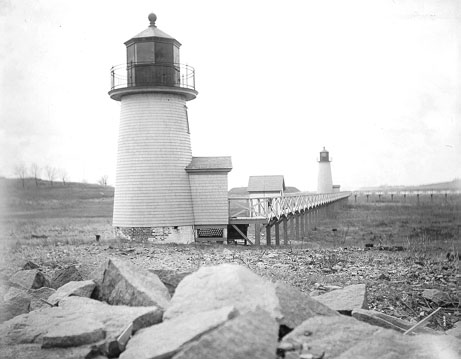Lovells Island Range Lights Station

Lovells Island Range Lights Station
Station Established: 1903
Height: 40 feet/31 feet
Torn Down: 1939
Amidst rock strewn shoreline and the drumlin meadows of Lovells Island resides a unique history that is part of the kaleidoscopic makeup of the Boston Harbor Islands. The remains of an oil shed are the only fragments from the time the island housed the Lovells Island Range Lights. These lights were beacons to marine vessels traveling in the South Channel to reach Boston.
Built in 1903, the Lovells Island Range Lights were constructed for ship captains to use as navigation tools as they passed through the rocks and shallows of Boston Harbor. The Range Lights were built 400 feet apart and had slightly different elevations. They were connected by a seven foot high wooden walkway that also joined the lightkeeper’s house and oil shed. If the ships travelled along the correct bearings, the lights would perfectly align with one behind the other. If the lights did not align, the captains knew they had to correct their course for fear of wrecking the ship.
The Boston Harbor Islands formed some 15,000 years ago as the result of glaciers slowly receding from the area, which raised the surrounding sea level and isolated the islands. These types of barrier islands are only found in Massachusetts and off the coast of Ireland. Lovells Island is situated close to the outer edge of the harbor, 7 miles from Boston and a little more than a mile from the city of Hull.
Named after Captain William Lovell, an early settler of Dorchester, the island has seen several shipwrecks. The most famous, the French warship Magnifique, ran aground in 1782. Throughout the years, people have thought they had discovered “treasure” from that shipwreck. The Humane Society of the Commonwealth of Massachusetts paid for the construction of “refuge or lifesaving huts” in 1787 after survivors from a shipwreck came ashore at Lovells Island, only to perish from the elements after a blizzard in the winter of 1786.
Native Americans used Lovells Island seasonally for fishing, gardening and trading. In colonial times, Charlestown received permission to harvest timber and fish from the island. Like many of the other nearby islands, it was also used as a quarantine station in the 1600’s. Fort Standish was built on the south end of the island in 1907. A variety of different machinery was placed there: such as three six inch disappearing guns, three ten inch disappearing guns, three three inch anti-aircraft guns and three three inch field guns. A few army families lived on the island as caretakers and the Army would practice firing the guns at different targets, some towed by plane. Fort Standish was deactivated in 1947.
The Range Lights were built at the north end of the island. Charles Jennings, former keeper at Boston Light on Little Brewster Island, became the keeper of the Lovells Island Range Lights in 1919. He and his family lived on the island until his retirement in 1939. Much of what life was like on the island comes from A Lighthouse Family, Growing Up at the Lovells Island Range Lights by Harold Jennings, the son of Charles’s. Harold was the last light range keeper on the island, taking over for his father as a “wickie” before the family moved back to the mainland.
The Range Lights stayed lit with kerosene. Captain Jennings would bring oil up to the lights at each sunset and place the oil in a reservoir tank. The oil slowly dripped throughout the night until the following sunrise feeding the wick of the lights, keeping it safely lit, according to Harold Jennings book. The wick also required trimming, bringing it down to its lowest point and then smoothing away what had burned so the wick would burn evenly. This is how the term “wickie” came about.
The taller tower light had a three foot diameter concave disc inside, made of nickel, plated with silver. It was kept brightly polished and it had a slot where a lamp would go through, its light reaching 15 miles from shore. The little tower had prisms and the kerosene lamp gave it light.
Many lighthouse keepers, including Charles Jennings according to his son, warned about “keeping your fingers off the brass work.” Each keeper had to repeatedly polish all the metal surfaces in their lighthouse or light station. The never-ending task gave birth to a poem Brasswork or The Lighthouse Keeper’s Lament.
The devil himself could never invent,
A material causing more world wide lament
And in Uncle Sam’s service about ninety per cent,
Is Brasswork.
The lamp in the tower, reflector and shade,
The tools and accessories pass in parade
As a matter of fact the whole outfit is made
Of Brasswork.
…
And when I’ve polished until I am cold
And I’m taken aloft to the Heavenly fold
Will my harp and my crown be made of pure gold?
No, Brasswork.
Bibliography
Jennings, Harold B., A Lighthouse Family: Growing Up at the Lovells Island Range Lights. Hingham, Friends of the Boston Harbor Islands, 2015.
“Islands You Can Visit – Lovells Island”. Boston Harbor Islands Partnership. Retrieved July 29, 2006
“Dictionary of the International Association of Lighthouse Authorities”. International Association of Lighthouse Authorities.
Bowditch, Nathaniel (2002). The American practical navigator : an epitome of navigation (2004 ed.). Bethesda, Md.: Paradise Cay Publications. p. 64. ISBN 9780939837540.
National Park Service Boston Harbor Islands “Lovells Island.” Date last modified February 26, 2015. https://www.nps.gov/boha/learn/historyculture/facts-love.htm